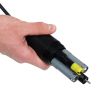YSI ProDSS Meter Tune-Up Service
Features
- Tune-up rate for the ProDSS multi-parameter water quality meters
- Meters are returned with a Calibration Report to confirm that all parameters meet specifications
- Fondriest Environmental is a factory-authorized YSI Service and Repair Center
- Expedited repair and warranty service
- Lifetime technical support
- More
Quality data can be directly correlated to the condition of your monitoring equipment. Instrument check-up, characterization, and certification by a factory-authorized service center are recommended on a regular basis to help ensure data accuracy and maximize the instrument’s usable life.
Fondriest Environmental offers excellent turnaround times and low service costs on YSI Professional Series meters. Tune-Up Service covers all repair labor in addition to:
- Seal Inspection & Cleaning
- Cable Inspection & Testing
- Sensor Reconditioning & Calibration
- Circuit Board Performance & Upgrade
Upon receipt of the instrument, repair technicians will perform a free evaluation and send a detailed evaluation report and price quote via email to the point of contact.
Repairs are based on customer feedback and are performed only after approval is received. All repaired instruments are returned with a Calibration Report to confirm that system parameters meet factory specifications.
Call our Service & Repair Department at 888.426.2151 or email customercare@fondriest.com for more information.
- Seals are cleaned of any contamination that may cause leakage
- Damaged or missing o-rings are replaced
- The cable is subject to a vigorous flex test to check for shorts
- Connector and ports are cleaned of any moisture and corrosion
- Sensors are reconditioned and calibrated so they are ready for use
- New DO membranes are installed with fresh electrolyte solution
- Circuit board performance is verified using a resistor box
- Software is upgraded to the latest version
- Calibration Report confirms that all parameters meet specifications
In The News
Save our Bogs! Culture, Conservation and Climate Action in Ireland’s Peatlands
Characterized by long-term accumulation under waterlogged conditions, peatlands exist on every continent and account for 3-4% of the global land surface . Small but mighty, these often overlooked wetland environments are estimated to hold as much as one-third of the world's organic carbon in their soil—twice the amount found in the entirety of the Earth's forest biomass. While healthy peatlands can trap and store carbon, regulate water, and provide important habitats for rare species, human alteration has disturbed peatland carbon and nitrogen cycles on a global scale. Approximately 12% of the world’s peatlands have been drained and degraded through conversion for agriculture, forestry, infrastructure development, and other uses.
Read MoreSargassum Surge: How Seaweed is Transforming our Oceans and Coastal Ecosystems
Until recently, Sargassum –a free-floating seaweed–was distributed throughout the Sargasso Sea , the north Caribbean Sea, and the Gulf of Mexico. But in the space of a decade, this seaweed has, as one scientist remarks , “Gone from a nonfactor to the source of a terrible crisis.” Driven by climate change, anomalous North Atlantic Oscillation in 2009-2010 and a glut of anthropogenic pollutants, sargassum has proliferated. Seasonally recurrent mats as deep as 7m now bloom in the “Great Atlantic Sargassum Belt” (GASB), which covers areas of the Atlantic from West Africa to the Caribbean Sea and Gulf of Mexico. Every year, millions of tons wash up along the shores of more than 30 countries . Dr.
Read MoreGreat Lakes Research Center: Designing Targeted Monitoring Solutions
According to the National Oceanic and Atmospheric Administration ( NOAA ), the Great Lakes have more miles of coastline than the contiguous Atlantic and Pacific coasts combined and contain 20 percent of the world's freshwater, making it a critical region to protect and conserve. Continuous monitoring and data-informed resource management are key components of managing waters in the region. Hayden Henderson, a research engineer with the Great Lakes Research Center (GLRC), designs and deploys monitoring platforms throughout the Great Lakes. With a background in environmental engineering, Henderson enjoyed the challenge of creating systems and making them work to obtain difficult, remote measurements.
Read More


















